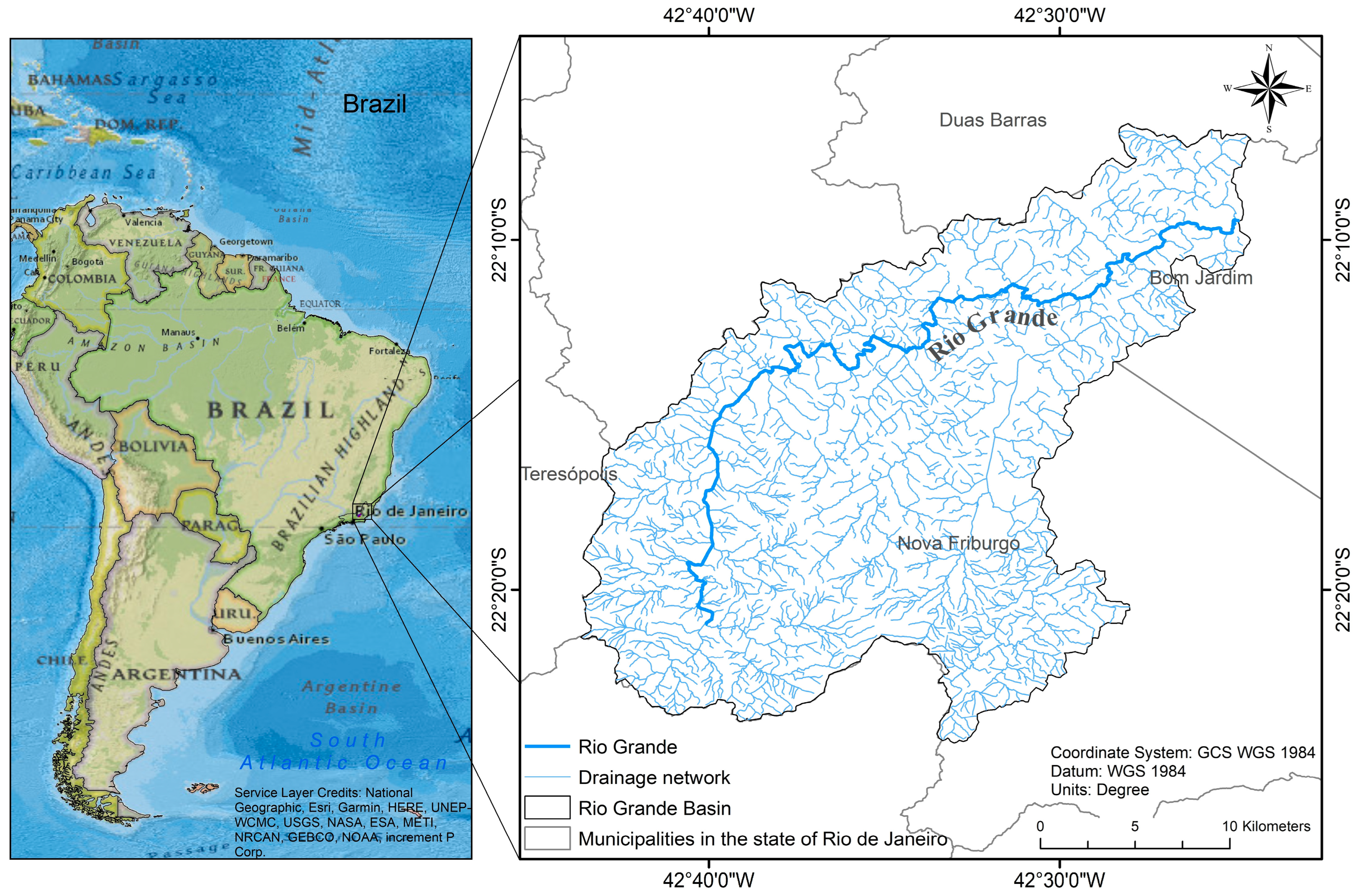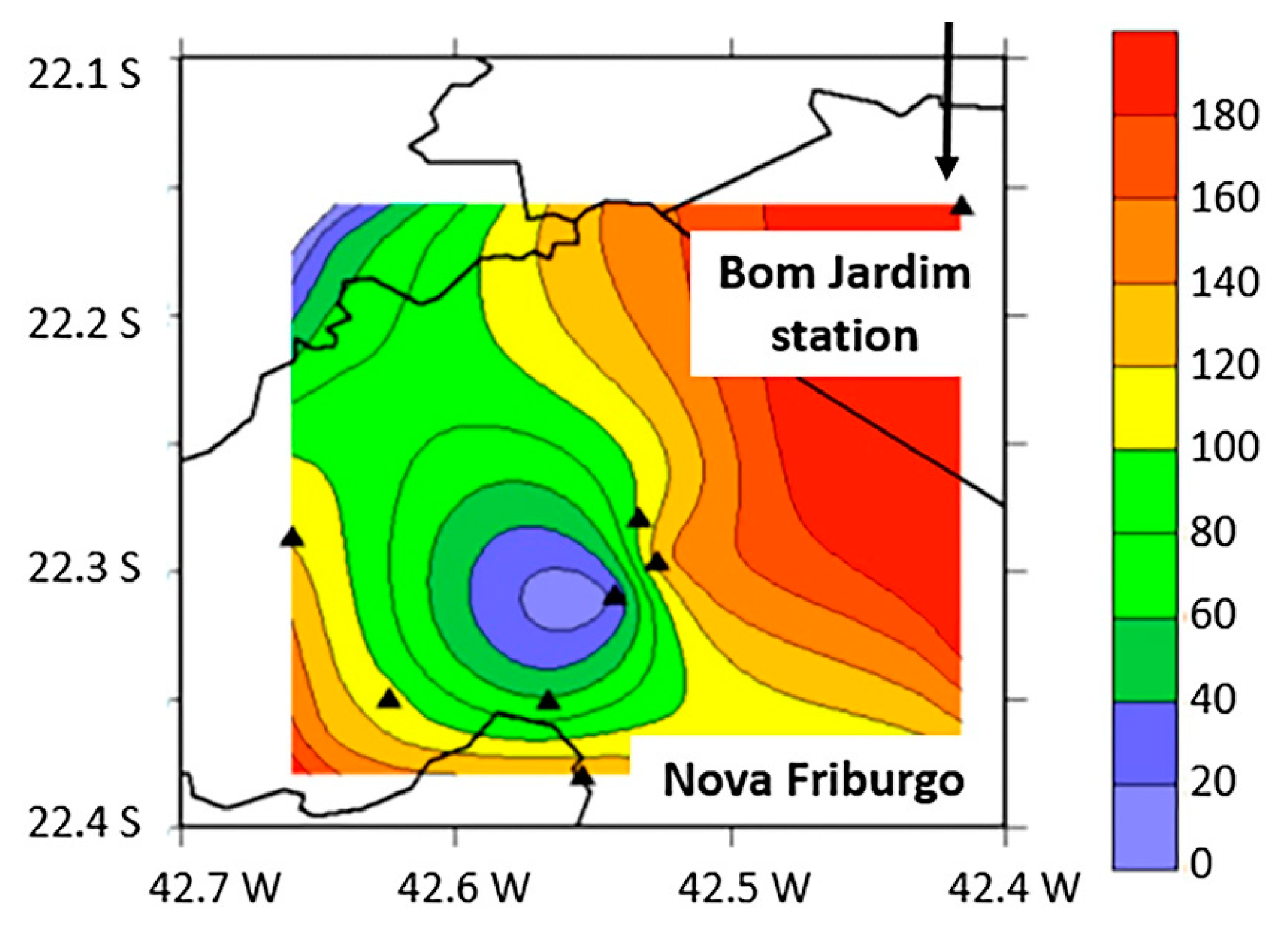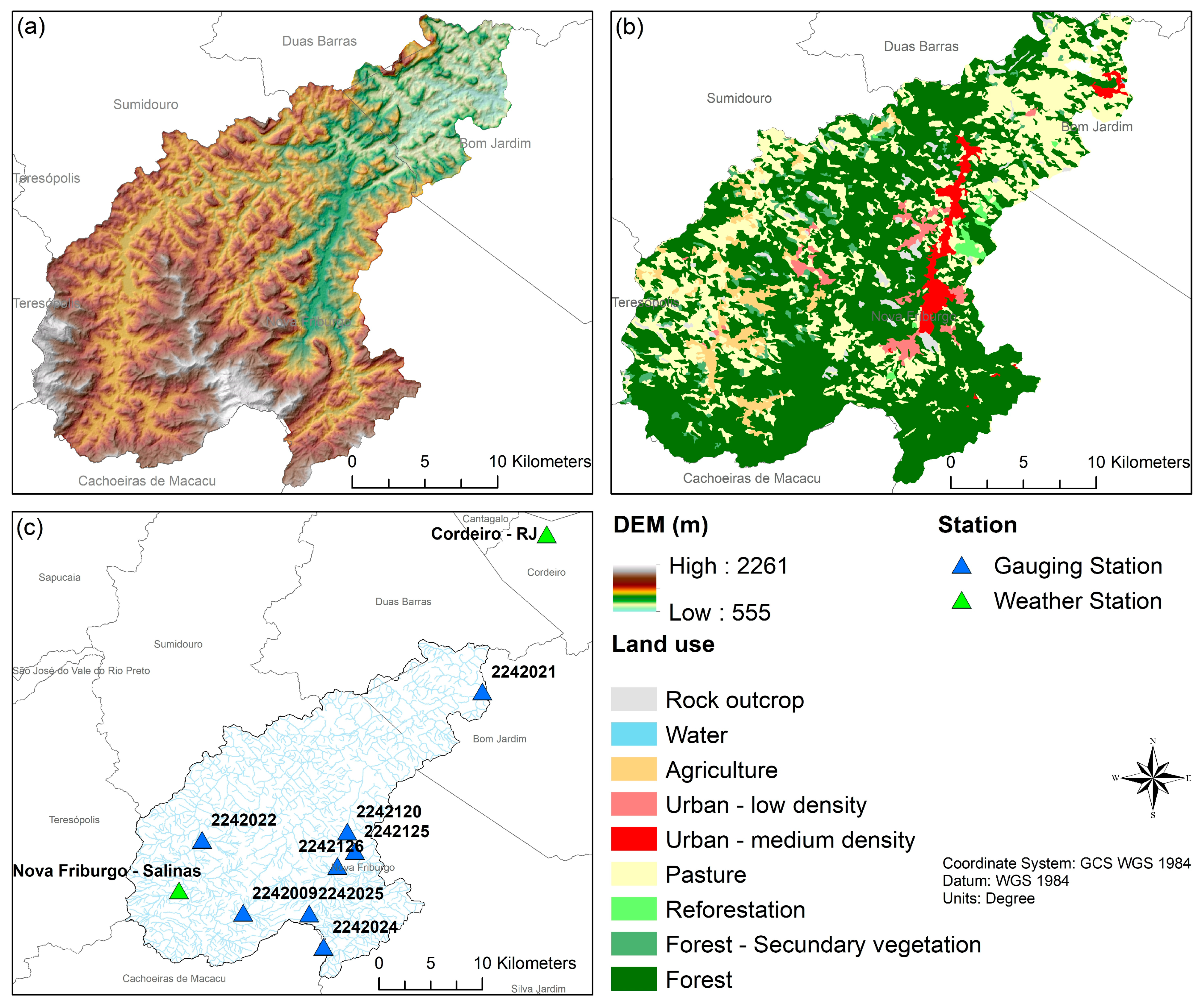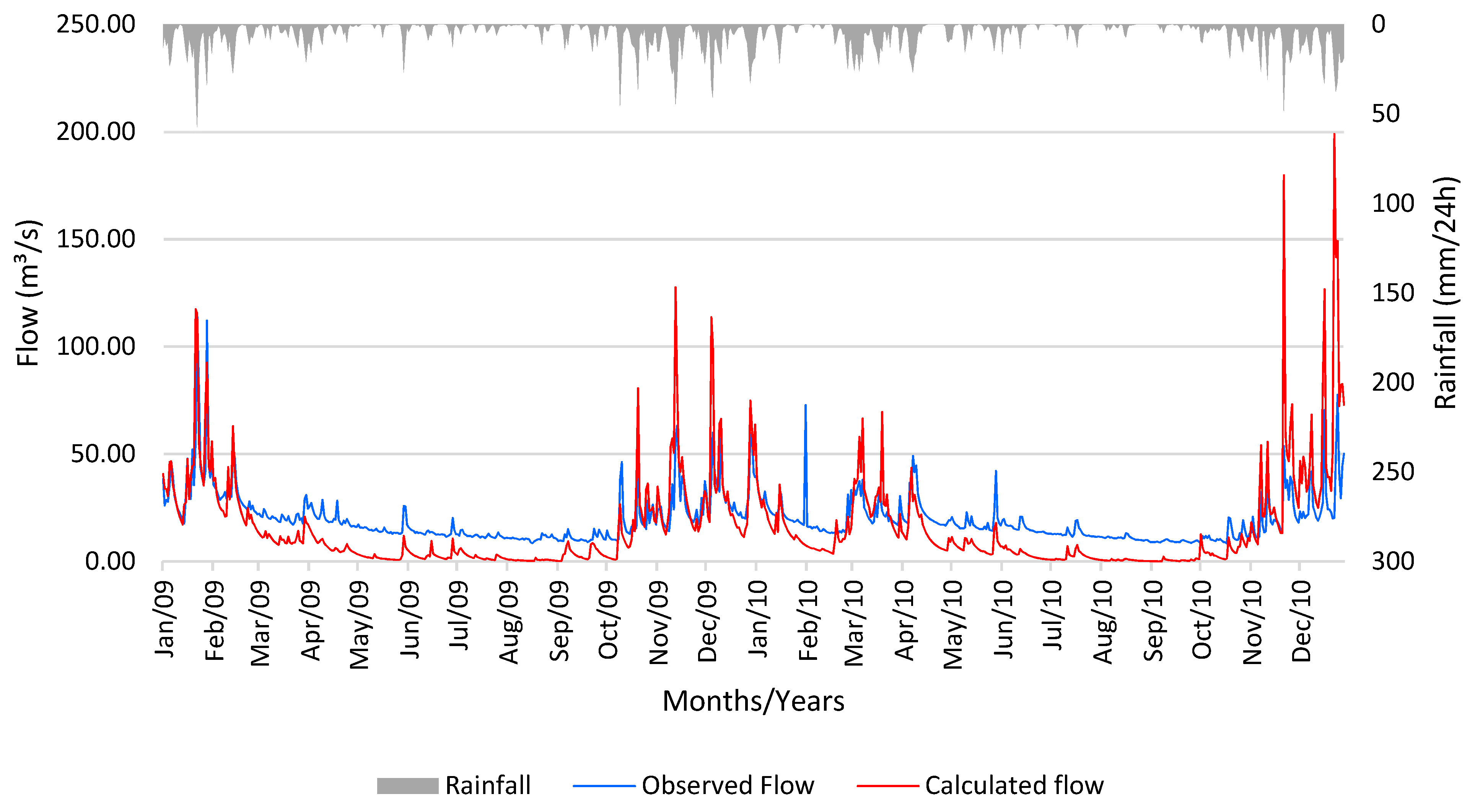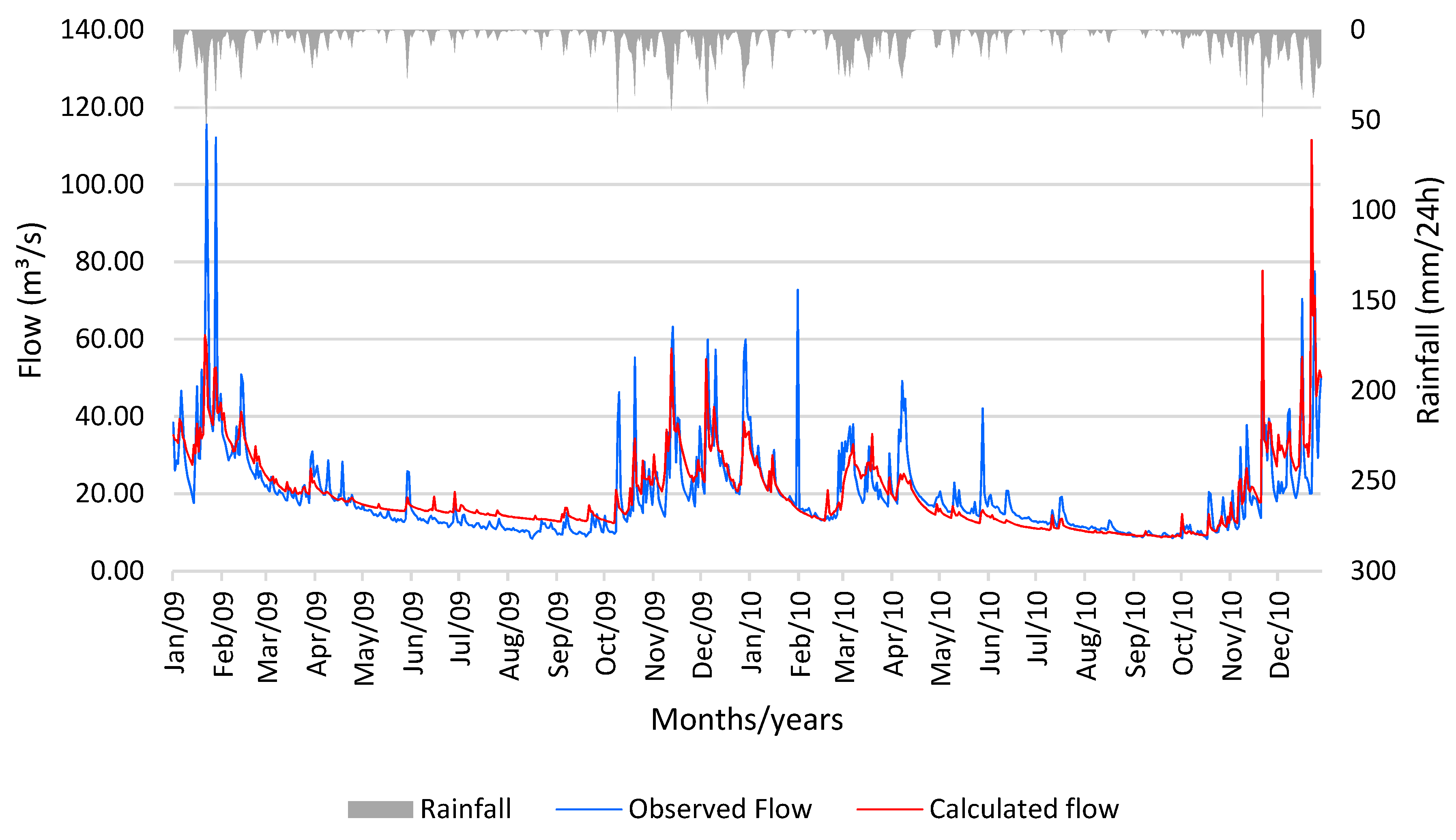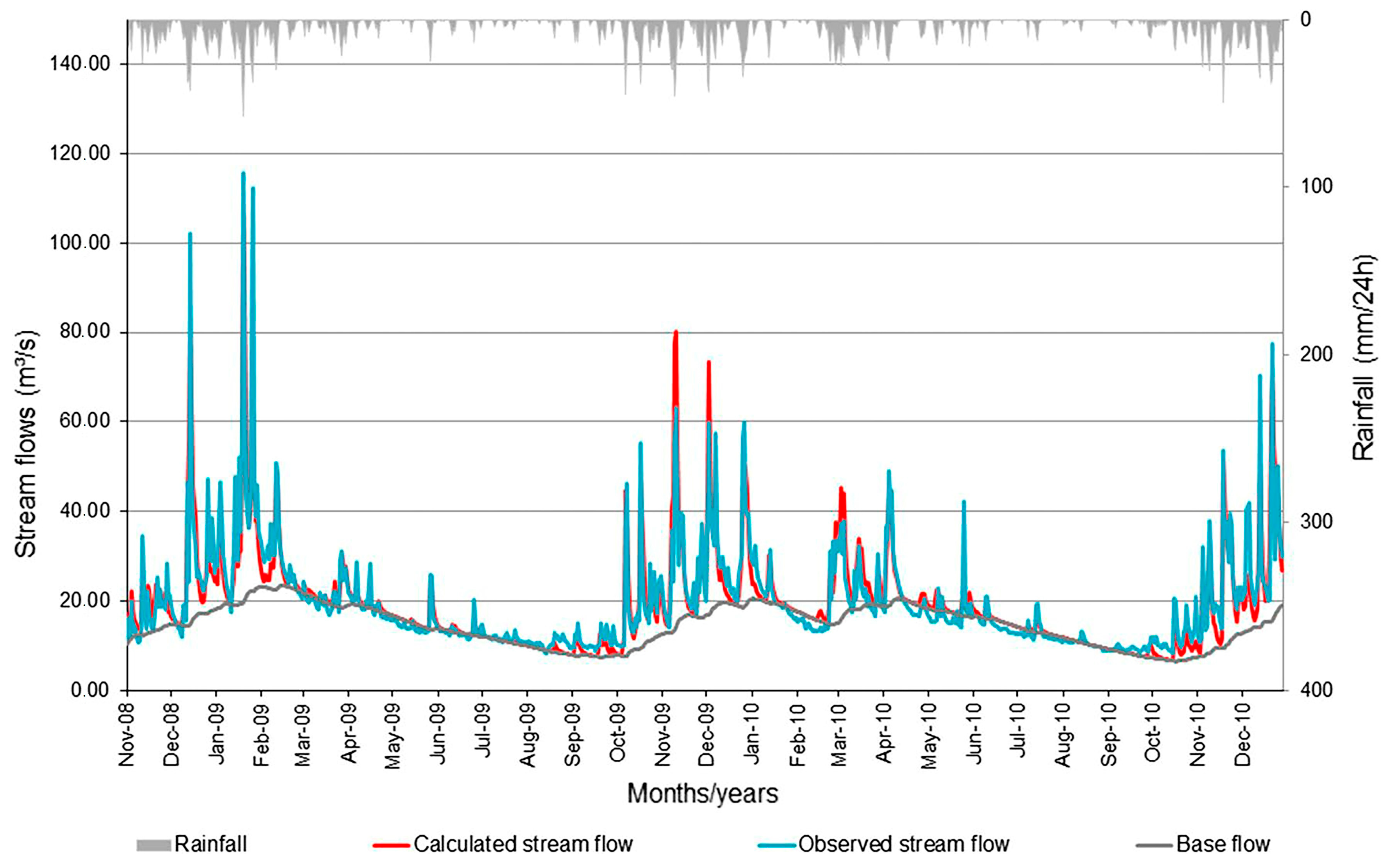2.1. Study Area
The watershed under study is located on the meridians 42°43′ W and 42°24′ W and parallels 22°6′ S and 22°24′ S, corresponding to the upper course of the Rio Grande Basin (RJ) (
Figure 1), with an area of approximately 558 km
2 and maximum elevation of 2261 m.
This region is characterized by the predominance of thick and leached soils, and by the humid and mild climate under the influence of orographic effects [
18]. The climate is mesothermal, with rainy summers (moderately hot) and dry winters of the Cwb type (Köppen–Geiger classification) [
19], as seen in
Figure 2. The total annual precipitation corresponds to 1500 mm and the average annual temperature of 18 °C; the highest temperature occurs in the month of January [
19].
Due to the climatic and relief characteristics, the vegetation type is dense montana ombrophilous forest [
20]. This coverage makes up the largest portion of the basin, followed by pastures and, finally, the urban areas that are not very expressive, concentrated in the eastern portion of Nova Friburgo.
2.2. The Natural Disaster in the Mountainous Region of Rio de Janeiro in 2011
On 11 and 12 January 2011, the mountainous region of the Rio de Janeiro, Brazil, suffered one of the country’s biggest disasters that caused about 905 deaths, 300 missing and affected more than 300,000 people [
21,
22].
The event marked by floods and landslides was the result of a set of climatic factors and local physical characteristics, as well as, land use and coverage, topography, and previous rainfall resulting from the establishment of the South Atlantic Convergence Zones (SACZ) over the region [
21].
The rainfall rates in the disaster period were above normal,
Figure 3; the Ypu, Sítio Santa Paula, Olaria and Nova Friburgo stations operated by the State Environment Institute (INEA) recorded, respectively, the accumulated totals of 222.8 mm, 240 mm, 241.8 mm and 182 mm in 24 h [
21,
22,
23].
On 11 January, the rains began calmly in the morning and throughout the day, triggering at 21 h the increase in rainfall intensity (strong to moderate) that lasted for eight consecutive hours [
24]. On this day, the spatial variation of precipitation observed in the basin under study showed accumulated values of 20 to 180 mm/24 h (
Figure 4) [
24]. These values exceed 70% of the historical average observed for the month in the region [
21].
The magnitude of the disaster took proportions beyond what has ever been seen in the country, not only by the impacts from flooding and inundation, but also by numerous mass movements triggered by heavy rains (
Figure 5), affecting especially the municipalities of Nova Friburgo, Petrópolis and Teresópolis [
3,
21]. According to the report conducted by the World Bank, it is estimated that the cost of losses and damages to the public and private sectors totaled approximately
$ 917 million [
21].
Historically, extreme events of hydrological origin occur frequently in the mountainous region of the Rio de Janeiro. The geomorphological aspects, such as steep slopes, high drainage, poorly developed soils, and the presence of fractures in the escapes, combined with the rainy season, favor the susceptibility to erosive and hydrological processes [
3,
26]. In addition, the occupation of irregular and risky areas makes these populations increasingly exposed to these events.
According to the report by the Ministry of the Environment, of the 657 landslides mapped in the municipality of Nova Friburgo, 90% occurred in areas with some anthropic intervention [
27]. Actions, such as deforestation and the opening of roads and pastures, have influenced erosion processes and the destabilization of slopes in this area [
27].
The disasters that occurred in the mountainous region of the state of Rio de Janeiro in 2011 show that prevention measures are essential to reduce the impacts. Real-time monitoring and prognosis of atmospheric events, river levels, and previous soil moisture conditions are essential measures to minimize the number of fatalities. Unfortunately, these actions have not been implemented, with no strengthening of civil defenses or the creation of situation rooms that could offer security to the population. Despite the progress in the legal framework and the development of new instruments to deal with natural disasters in the country, this became evident in other events that occurred in the same mountainous region, such as the one in Petrópolis in 2022, where again there was a large number of deaths.
2.3. SWAT Hydrological Model
The SWAT hydrological model is continuous in time, conceptual and based on physical processes that operate in daily time steps [
12]. In this model, the watershed is divided into sub-basins consisting of a set of hydrologic response units (HRUs), defined by homogeneity in management, soil type, and land use and land cover, which contributes to improved representation of the study area and accuracy in the simulations [
10].After the simulation in the land phase, the products such as flow, sediment, nutrients, pesticides and bacteria are routed in the main channel of each sub-basin and subsequently summed over the watershed [
9]. All physical processes are governed by the watershed water balance summarized in Equation (1).
where
is the final amount of water in the soil (mm H
2O).
is initial soil water moisture on day
i (mm H
2O).
T is the time (days).
is the precipitation (mm H
2O).
is the runoff per unit area on day
i (mm H
2O).
is the evaporation on day
i (mm H
2O).
is the water entering the wetland from the soil profile on day
i (mm H
2O).
is the return flow rate on day
i (mm H
2O).
2.3.1. SWAT Input Data
SWAT’s main input data correspond to the digital elevation model (DEM), the land use and land cover map, the pedology map and its physical parameters, and the climatic data, summarized in rainfall, minimum and maximum temperature, solar radiation, relative humidity, and wind speed.
The DEM allows SWAT to calculate slope and generate the hydrographic network and subbasins. The study basin was delineated from the DEM (
Figure 6a) of 30 m spatial resolution obtained from the Shuttle Radar Topographic Mission (SRTM) (
https://earthexplorer.usgs.gov/ (accessed on 18 April 2018)) [
28]. The use of this product for the Brazilian territory is satisfactory for a scale of between 1:50,000 and 1:100,000 [
29]. Furthermore, this version of DEM SRTM showed better results when compared to ALOSWorld 3D and ASTER GDEM v.2 products [
30].
The land use and land cover map was obtained from the geospatial database of the State Environmental Institute (INEA) (
https://inea.maps.arcgis.com/home/index.html (accessed on 25 April 2018)) [
31]. The map of the year 2007 at the scale of 1:100,000 was used, since it characterized the landscape features prior to the event (
Figure 6b).
For comparison purposes, the rainfall data were taken from the study [
17], the authors selected the stations with coincident periods and that presented at least 5 years of data. These are available in the Hidroweb database (
http://hidroweb.ana.gov.br (accessed on 3 May 2018)) of the National Water Agency (ANA) and in the flood alert system created by INEA (
http://alertadecheias.inea.rj.gov.br (accessed on 3 May 2018)) (
Figure 6c and
Table 1).
Due to the need to heat the SWAT model, the time series of rainfall data used corresponded to the period 1 January 2008 to 15 January 2011, and the flow data from 1 January 2009 to 15 January 2011, acquired from the fluviometric station Bom Jardim (58827000), situated at the same location as the rainfall station (2242021). Through the stations operated by INMET (
Figure 6c), the solar radiation and wind speed data were obtained through the Nova Friburgo-Salinas station, while the relative humidity and minimum and maximum temperature data were obtained through the Cordeiro-RJ station. In the cases of missing data, the global climate generator CFSR (Climate Forecast System Reanalysis), provided by the National Centers for Environmental Prediction (NCEP) (
https://globalweather.tamu.edu/ (accessed on 5 May 2018)) was applied.
The pedological map of the basin corresponds to the soil map of the Geoenvironmental Study of the State of Rio de Janeiro, published in 2000, at the scale of 1:250,000 and executed by the Brazilian Agricultural Research Corporation (EMBRAPA) [
32]. The soil classes adopted are based on the first level exposed in
Table 2, while the physical parameters are obtained from the literature, and sources expressed in
Table 3.
2.3.2. Calibration and Validation of SWAT
Calibration is the step of adjusting the model by varying its sensitive parameters in order to obtain the best relationship between a given time series of observed or estimated data and the data predicted in the modeling. SWAT has a range of parameters aimed at hydrological, sedimentological, nutrient and pesticide calibration. Because of the lack of other data, this simulation was limited to the hydrologic calibration by comparing the estimated flow data with those calculated by the model. Once the model is calibrated, the validation of the desired period is performed. The most sensitive calibration parameters and their modifications are observed, as shown in
Table 4.
Thus, the minimization of lateral runoff was sought through the SOL_K parameters, while, to increase water retention in the aquifer and the consequent elevation of the base flow, modifications were assigned to the GW_DELAY and CANMX values and, finally, to reduce the peaks, the CN and RCHRG_DP values were altered. It is noteworthy that in the SOL_K parameter, initially the value was changed for all soil classes, and later a new change occurred only for the areas that were Cambissolo type, because this presents the highest conductivity among the remaining soils.
The calibration occurred in the period from 1 January 2008 to 28 December 2010, in view of the heating of one year adopted in 2008. The flow data for the month of January 2011 used in the validation were results of constitutions through interpolations of neighboring posts made by ANA due to the lack of measurements in this period. Although the event occurred on the 11th and 12th, the flood wave, in this constitution, occurs on the 14th, so the series analysis was performed until the 15th. Therefore, the validation occurred in the period from 1 January 2011 to 15 January 2011.
The reliability of the simulation is defined by the efficiency coefficients and statistical relationships that compare the observed or estimated data to that obtained from the modeling. The mean relative error (MRE) provides a concise evaluation, as it defines the error percentage between the observed and predicted data. In this sense, this coefficient was used in the evaluation of the simulation accuracy, expressed in Equation (2). Where
is the observed event,
is the average of observed events;
is the simulating event and
is the number of events.
2.4. SMAP Hydrological Model
The deterministic, conceptual and concentrated model, SMAP, was developed in 1981 and operates in daily time steps; however, monthly or hourly intervals are possible in other versions, whose calibration can be performed manually and automatically [
16]. In the daily simulation version, water storage and flux represented by SMAP result from the moisture balance of the linear soil, aquifer and surface reservoirs, expressed in Equations (3)–(5).
where
is the accumulated water volume in the soil reservoir on day
t (mm).
is the volume of water accumulated in the underground reservoir on day
t (mm).
is the volume of water accumulated in the surface reservoir on day
t (mm).
is the average precipitation in the basin on day
t (mm).
is the runoff in the river section on day
t (mm).
is the runoff from the surface reservoir on day
t (mm).
is the potential evapotranspiration in the basin on day
t (mm).
is the recharge transferred from the soil reservoir to the underground reservoir on day
t (mm) and
is the baseflow on day
t (mm).
